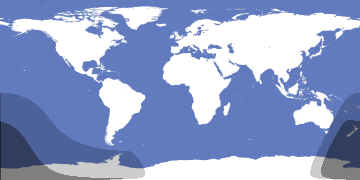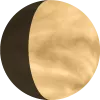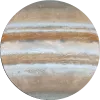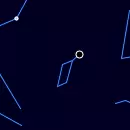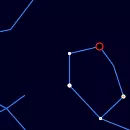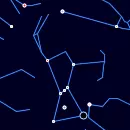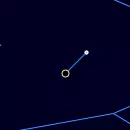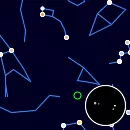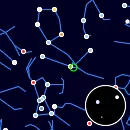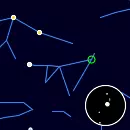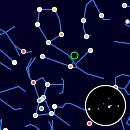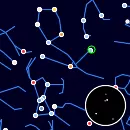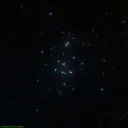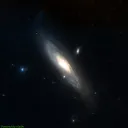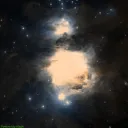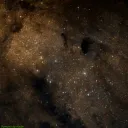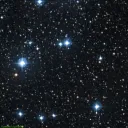Sky Tonight
Whether you're using just your eyes, binoculars, or a telescope, the night sky offers endless wonders waiting to be discovered. Happy stargazing!Sky Map
Celectial bearing and elevation at 18:03
This skymap is a dynamic visualization that displays the positions of celestial objets in the night sky for your specific location on the current date. It allows you to interactively explore the celestial landscape by moving it horizontally, enabling you to preview how the arrangement of stars will change as the night progresses.
Celestial Delights for Your Night Sky Adventure
Tonight's celestial wonders are ready to amaze and inspire. Here's a brief list of what you can explore:
Solar System Objects
Moon
Waning Crescent (1%)
The Moon exhibits a stunning array of craters, mountains, and lunar maria, showcasing its rugged and varied surface in intricate detail, with phases changing as it orbits Earth.
Approaching Eclipses
Discover eclipses happening soon. This section lists solar and lunar eclipses that will occur within the next 30 days, with details on dates, visibility areas, and best viewing times. If you want to know when and where the next eclipse will be visible, check here to plan your observation and make sure you don’t miss these rare astronomical events.
Sun, 21 September 2025
Partial Solar Eclipse
| Global | From Your location | |
|---|---|---|
| Penumbra | 08:31-12:55 | Not Visible |
| Umbra | - | Not Visible |
Planets
See which planets are currently visible, along with their rise and set times, to help you plan your observations.
Venus
Inner Planet
Venus, the "Evening Star" or "Morning Star", entices stargazers with its changing phases, transitioning from a slender crescent to a nearly full disc, all while radiating remarkable brilliance and standing out in the night sky.
Jupiter
Outer Planet
Jupiter presents a captivating view with its prominent cloud bands, the iconic Great Red Spot, and up to four of its largest moons: Io, Europa, Ganymede, and Callisto.
Saturn
Outer Planet
Saturn, the "Ringed Giant", enchants stargazers with its stunning ring system and gas giant beauty in the night sky.
Active Meteor Showers
The sky is quiet at the moment, with no major meteor showers underway.
For a complete list of meteor showers, go to our Active Meteor Showers page.
Satellite Flyovers
A short list of upcoming brightest satellite flyovers.
No bright satellite flyovers are expected in the next hour.
To view the complete list, visit our Satellites page.
Brightest Stars
Check out the five brightest stars currently visible in the night sky.
Vega
Star
Vega, the fifth brightest star, is part of the constellation Lyra. It is one of the most luminous stars visible from Earth and a prominent member of the Summer Triangle asterism.
Capella
Star
Capella, the sixth brightest star, is a yellow giant located in the constellation Auriga. Its brightness and close proximity to the celestial north pole make it easily identifiable.
Rigel
Star
Rigel, the seventh brightest star, is a blue supergiant in the constellation Orion. It is one of the most massive and luminous stars visible to the naked eye.
Procyon
Star
Procyon, the eighth brightest star, is a binary system in the constellation Canis Minor. Its name means 'before the dog' as it rises just before Sirius, the 'Dog Star'.
Betelgeuse
Star
Betelgeuse, the tenth brightest star, is a red supergiant in the constellation Orion. It is one of the largest known stars and exhibits noticeable variability in brightness.
If you've enjoyed learning about these five stunning celestial wonders, don't miss out on exploring our list of the brightest stars in the night sky
Double Stars
Discover the brightest double stars currently visible in the night sky.
05061+5858
Multiple Star System
5-star star system in the constellation Camelopardalis with primary and secondary components of magnitudes 5.00 and 6.21, separated by 3 arcminutes.
04287+1552
Multiple Star System
8-star star system in the constellation Taurus with primary and secondary components of magnitudes 3.74 and 3.94, separated by 5.7 arcminutes.
20210-1447
Multiple Star System
8-star star system in the constellation Capricornus with primary and secondary components of magnitudes 3.10 and 6.08, separated by 3.4 arcminutes.
04254+2218
Multiple Star System
8-star star system in the constellation Taurus with primary and secondary components of magnitudes 5.20 and 5.29, separated by 5.7 arcminutes.
03459+2433
Multiple Star System
6-star star system in the constellation Taurus with primary and secondary components of magnitudes 5.75 and 6.42, separated by 2.5 arcminutes.
Nebulae
Discover the brightest nebulae currently visible in the night sky.
Beehive (M44)
Open Cluster
The Beehive Cluster, an open star cluster containing over 1,000 stars, located approximately 577 light-years away in the constellation Cancer.
Andromeda Galaxy (M31)
Galaxy
The Andromeda Galaxy, the nearest spiral galaxy to the Milky Way, containing over a trillion stars, located approximately 2.537 million light-years away.
Orion Nebula (M42)
Star cluster + Nebula
The Orion Nebula, a bright emission nebula and star-forming region, containing over 700 stars, located approximately 1,344 light-years away in the constellation Orion.
Small Sagittarius Star Cloud (M24)
Association of stars
The Sagittarius Star Cloud, a vast Milky Way star field and nebulous region, visible to the naked eye in the constellation Sagittarius.
M39
Open Cluster
An open star cluster containing approximately 30 stars, located approximately 800 light-years away in the constellation Cygnus.
For a complete list of nebulae visible tonight, go to our Nebulae Page. There, you'll find detailed information on each nebula, including its location, brightness and photos.



